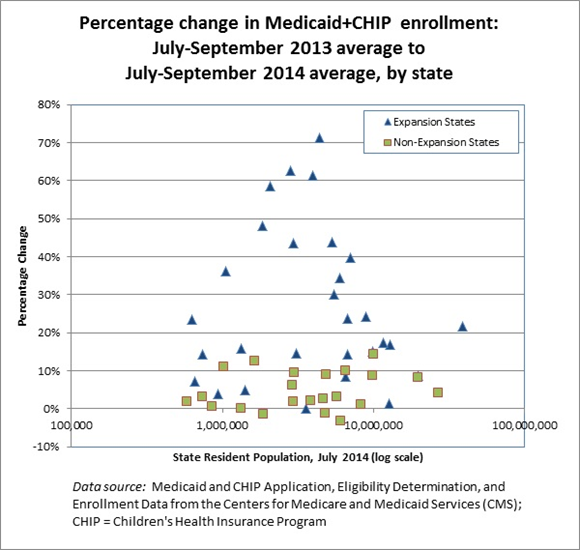More Timely Medicaid Data Helps Improve Small Area Health Insurance Estimates
More Timely Medicaid Data Helps Improve Small Area Health Insurance Estimates
Medicaid enrollment figures are among the key data inputs for the Census Bureau’s Small Area Health Insurance Estimates (SAHIE) of the number of uninsured for all U.S. counties and states. The 2014 SAHIE utilizes more timely Medicaid data than were available in the past. The release includes an updated version of 2013 SAHIE using the new Medicaid data methods, which provides a basis of comparison both for 2013-2014 SAHIE trends and for the original 2013 SAHIE.
In late 2013, the Centers for Medicare and Medicaid Services began releasing state-level monthly Medicaid totals more quickly via a new data source. This allowed the Census Bureau to reduce the two-year lag of the detailed Medicaid Statistical Information System data used in SAHIE’s models.
By incorporating up-to-date Medicaid data from the Medicaid and Children’s Health Insurance Program (CHIP) Application Eligibility Determination and Enrollment Data, the 2014 SAHIE and updated 2013 SAHIE factor in estimates of the large 2013-2014 Medicaid enrollment changes. Comparisons of the SAHIE results for a given year under both the old and new Medicaid data show greater consistency with the American Community Survey estimates for counties with smaller populations when using the new Medicaid data. This Medicaid data update is one example of how SAHIE continually strives to improve its data inputs and methodology, employing the latest available and reliable data sources and statistical methods each release year.
SAHIE’s updated Medicaid input data combine information from three Medicaid data sources: Medicaid Statistical Information System (MSIS), Medicaid and CHIP Application and Eligibility Determination and Enrollment Data (MCAEDED), and Kaiser Family Foundation Medicaid data (KFF data). As shown in the above table, 2012 Medicaid Statistical Information System data were the latest year available for most states as of October 2015, meaning that 2014 SAHIE production would have had to use Medicaid data from two years prior. In contrast, the state-level Medicaid and CHIP Application and Eligibility Determination and Enrollment Data were available from 2013 onward, including for 2014, making it possible for 2014 SAHIE production to avoid the Medicaid data lag. The 2013 Kaiser Family Foundation data provide a crucial bridge between the end of the Medicaid Statistical Information System data series in 2012 and the start of the MCAEDED series in 2013, and it also provides some data by demographic characteristics.
Using updated Medicaid data for 2013 and 2014 SAHIE may be especially important given the major programmatic changes that affected Medicaid under the Patient Protection and Affordable Care Act during this time period. For instance, states now had the option to expand Medicaid eligibility to most non-elderly adults with incomes up to 138 percent of poverty. Even states that did not expand Medicaid eligibility had some other Medicaid programmatic changes in 2014 related to the Affordable Care Act.
The above figure plots the percentage change in Medicaid and CHIP enrollment between 2013 and 2014, using MCAEDED, with triangles for Medicaid expansion states and squares for Medicaid non-expansion states, defined as of May 2015 by the Centers for Medicare and Medicaid Services. The states that expanded their Medicaid eligibility criteria tend to have larger percentage changes than the states that did not. Hence, by incorporating more up-to-date Medicaid data, SAHIE was able to account for the large 2013-2014 enrollment changes displayed in the above figure.
SAHIE publishes single-year health insurance coverage estimates for all U.S. counties and states annually, with detail for five age groups, six income groups, by sex, and by race/Hispanic origin (for states only). The income groups include 0-138 percent of poverty and 138-400 percent of poverty, making SAHIE a vital source for evaluating county-level health insurance coverage. Our other recent blog posting discusses 2013-2014 changes in the uninsured rate using SAHIE.
The SAHIE program’s updated Medicaid data sources and methods are described in greater detail in “Medicaid and CHIP Data Methodology for SAHIE Models,” a 2015 Federal Committee on Statistical Methodology research conference paper [PDF]. SAHIE team members presented this work last December at the 2015 FCSM Research Conference. In August 2015, team members gave a short presentation about the SAHIE program’s research efforts at the Census Bureau’s Technical Meeting on Income, Poverty and Health Insurance, and in March 2015, the SAHIE program’s Medicaid research plans were mentioned within the Census Bureau’s Expert Meeting on Income, Poverty and Health Insurance.
The SAHIE team continues to welcome any feedback on its Medicaid data methods and/or other production methods at any time. The SAHIE website contains information about the SAHIE program’s statistical methodology and the use of its various source data sets. Data users can reach the SAHIE team with any questions or comments at [email protected] or at 301-763-3193.





